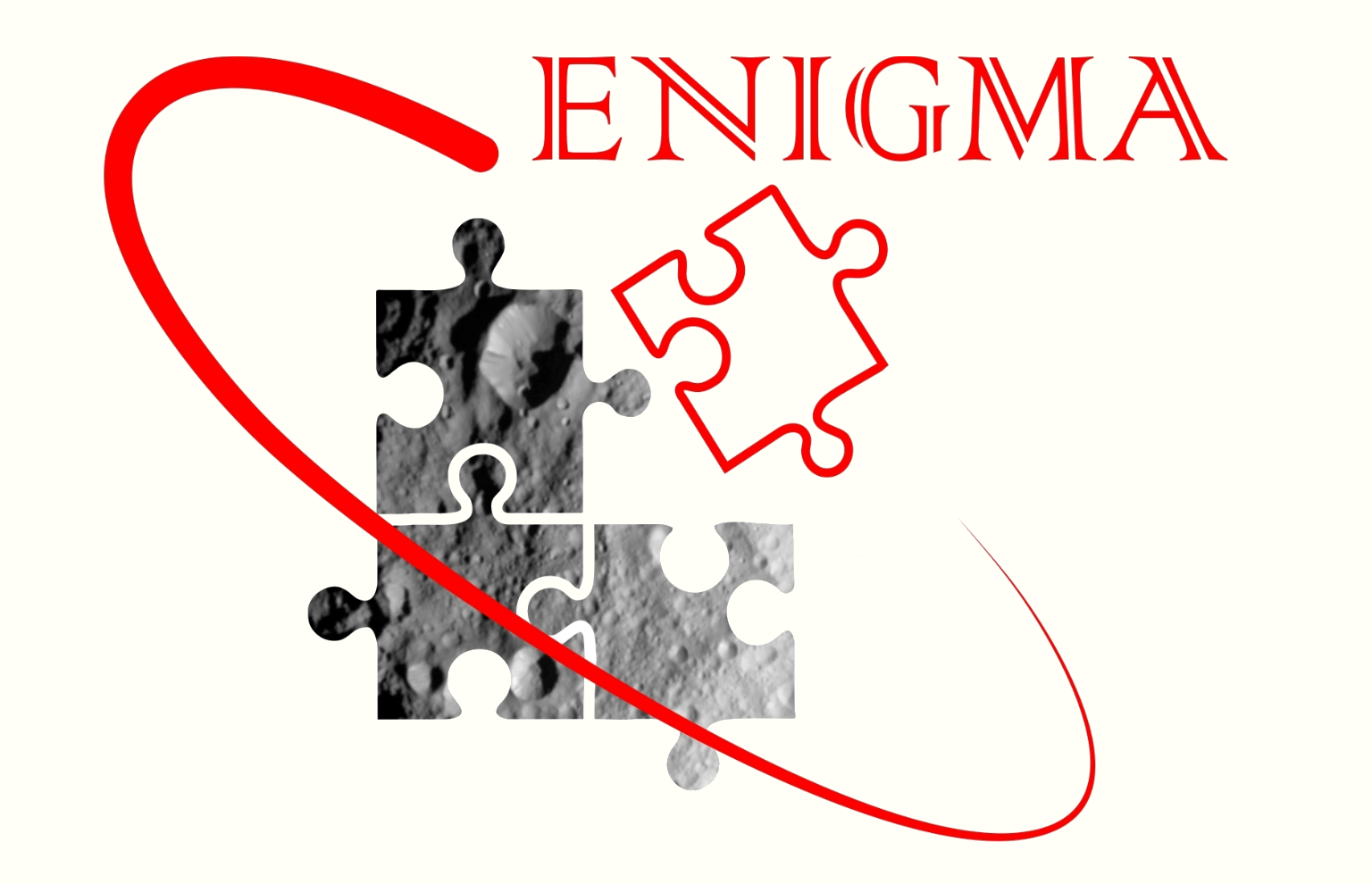
Science Fund of the Republic of Serbia:
ENIGMA
Demystifying enigmatic visitors of the near-Earth region
Motivation and project's objectives
Along with comets, asteroids are the closest analog we have to the planetesimals involved in planet
formation. A subpopulation of asteroids and comets, known as near-Earth objects (NEOs), poses a
significant danger since some will eventually strike the Earth. The hazard posed by asteroid impacts on our
civilization is low but singular. The design of an efficient deflection strategy strongly depends on asteroids'
timely detection by our surveys and on knowledge of their properties. Asteroids are not only a threat to
humans but also may become a valuable resource in the future. Again, a critical prerequisite is to learn a
great deal more about their nature.
Enhancing the interplay among scientific research, human exploration, and the utilization of resources
presents a paramount challenge and opportunity for asteroid studies in the 21st century. Of particular
importance are the near-Earth asteroids (NEAs), which orbit close to our planet. Despite increasing
global efforts to comprehensively understand asteroids, with a focus on NEAs, critical areas still
demand urgent attention, especially concerning objects smaller than 150 meters. These smaller NEAs,
far more abundant than their larger counterparts, pose a more frequent threat to Earth due to their
higher likelihood of impact. A notable example is the Chelyabinsk meteor, a modestly sized asteroid
about 17 meters across, which disintegrated over Chelyabinsk, Russia, on February 15, 2013. The explosion's
energy surpassed 470 kilotons of TNT, and the ensuing shock wave resulted in injuries to approximately
1,200 individuals.
NASA's DART (Double Asteroid Redirection Test) is the first-ever space mission to demonstrate
asteroid deflection by the kinetic impactor. On September 26th, it impacted Dimorphos, the small moonlet of
the larger asteroid Didymos, to adjust its speed and path. The test successfully changed the orbital period of
Dimorphos around Didymos, showing that kinetic impact is a viable technology to deflect potential Earth
impactors. It is, however, also a wake-up call for scientists involved in planetary defence! The modification
of the orbital period is 32 min, 3-13 times the one predicted by the state-of-the-art models before the
impacts. It clearly demonstrates the limitations of the available models and the insufficiency of knowledge
of the properties of NEAs. This is why we need to act immediately. For these reasons, the scientific
objectives of the ENIGMA project target small near-Earth asteroids, and the project will address
some emerging problems in our understanding of these objects.
Observational data indicate that super-fast rotating entities are prevalent among small near-Earth objects,
with their rotational periods ranging from a few seconds to a couple of months. Notably, most NEAs
exhibit rotational periods exceeding ~2.2 hours, a duration often described as the spin barrier.
This threshold represents the maximum rotational period a cohesionless, spherical rubble pile asteroid,
bound solely by gravitational forces, can sustain before centrifugal forces initiate its disintegration.
Recent findings, however, reveal exceptions to this rule for asteroids smaller than approximately 150-200 meters,
suggesting that rapid rotation is a common trait among smaller asteroids. Consequently, this group of super-fast
rotators constitutes a significant yet enigmatic subset of the NEA population, whose characteristics remain
largely unexplored. Unraveling the mysteries of these swift celestial bodies is a primary objective of the
ENIGMA project, aiming to shed light on these elusive inhabitants of the near-Earth space.
The key scientific objectives of ENIGMA project
To characterize surface material properties of small rapidly rotating asteroids with the measured Yarkovsky drift rates
To validate analytical Yarkovsky models for super-fast rotators
To explain why most small NEAs rotate rapidly
To explain what factors allow those objects to survive fast rotation
Motivation and project's objectives
Along with comets, asteroids are the closest analog we have to the planetesimals involved in planet formation. A subpopulation of asteroids and comets, known as near-Earth objects (NEOs), poses a significant danger since some will eventually strike the Earth. The hazard posed by asteroid impacts on our civilization is low but singular. The design of an efficient deflection strategy strongly depends on asteroids' timely detection by our surveys and on knowledge of their properties. Asteroids are not only a threat to humans but also may become a valuable resource in the future. Again, a critical prerequisite is to learn a great deal more about their nature.
Enhancing the interplay among scientific research, human exploration, and the utilization of resources presents a paramount challenge and opportunity for asteroid studies in the 21st century. Of particular importance are the near-Earth asteroids (NEAs), which orbit close to our planet. Despite increasing global efforts to comprehensively understand asteroids, with a focus on NEAs, critical areas still demand urgent attention, especially concerning objects smaller than 150 meters. These smaller NEAs, far more abundant than their larger counterparts, pose a more frequent threat to Earth due to their higher likelihood of impact. A notable example is the Chelyabinsk meteor, a modestly sized asteroid about 17 meters across, which disintegrated over Chelyabinsk, Russia, on February 15, 2013. The explosion's energy surpassed 470 kilotons of TNT, and the ensuing shock wave resulted in injuries to approximately 1,200 individuals.
NASA's DART (Double Asteroid Redirection Test) is the first-ever space mission to demonstrate asteroid deflection by the kinetic impactor. On September 26th, it impacted Dimorphos, the small moonlet of the larger asteroid Didymos, to adjust its speed and path. The test successfully changed the orbital period of Dimorphos around Didymos, showing that kinetic impact is a viable technology to deflect potential Earth impactors. It is, however, also a wake-up call for scientists involved in planetary defence! The modification of the orbital period is 32 min, 3-13 times the one predicted by the state-of-the-art models before the impacts. It clearly demonstrates the limitations of the available models and the insufficiency of knowledge of the properties of NEAs. This is why we need to act immediately. For these reasons, the scientific objectives of the ENIGMA project target small near-Earth asteroids, and the project will address some emerging problems in our understanding of these objects.
Observational data indicate that super-fast rotating entities are prevalent among small near-Earth objects, with their rotational periods ranging from a few seconds to a couple of months. Notably, most NEAs exhibit rotational periods exceeding ~2.2 hours, a duration often described as the spin barrier. This threshold represents the maximum rotational period a cohesionless, spherical rubble pile asteroid, bound solely by gravitational forces, can sustain before centrifugal forces initiate its disintegration. Recent findings, however, reveal exceptions to this rule for asteroids smaller than approximately 150-200 meters, suggesting that rapid rotation is a common trait among smaller asteroids. Consequently, this group of super-fast rotators constitutes a significant yet enigmatic subset of the NEA population, whose characteristics remain largely unexplored. Unraveling the mysteries of these swift celestial bodies is a primary objective of the ENIGMA project, aiming to shed light on these elusive inhabitants of the near-Earth space.
